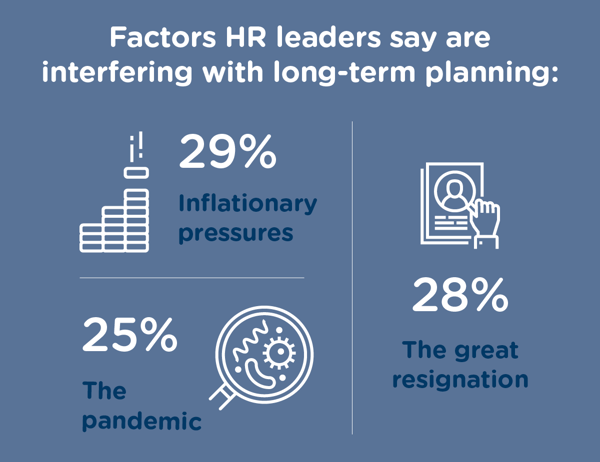Most businesses recognise the urgent need to attract, retain and engage their employees, but as they look towards the future of their engagement strategies, many factors are interfering with their long-term planning. When planners are faced with so many unknowns and blind spots, agility can be a powerful tool.
But only one in five Australian HR leaders say their employee engagement strategy allows them to adapt quickly to the needs of employees as they change.
Our latest research on employee engagement trends for 2023 revealed key factors that are inhibiting long-term planning for HR. Let’s take a closer look at how these are impacting businesses, and how to make your strategies flexible and built to last.

Inflation and rising cost of living

29% of respondents pointed to inflationary pressures getting in the way of planning for new initiatives in 2023. Rising costs and limited budgets are familiar challenges for most organisations, and as teams strive to adapt and find ways to do more with less, new employee engagement initiatives have fallen down their list of priorities.
Remember that while businesses face increased costs, so do employees, and developing new ways to keep your teams engaged and motivated is more important than ever. Employee engagement doesn’t have to be expensive, and there are many low-cost initiatives to look at even during challenging financial times. Consider budget-friendly ways to recognise and boost morale, or stretch their disposable income to help them deal with inflation.
The pandemic
While it might feel like we’re nearly out of the woods, the pandemic is still a top concern for 25% of respondents. For many businesses, the pandemic still presents a great uncertainty for the future, while other businesses are still getting back on their feet after a few difficult years.
The pandemic has also changed how and where we work, and has led to a new wave of hybrid and remote working that is here to stay. Finding new ways to motivate your hybrid or remote workforce, as well as providing them with tools to recognise each other are great ways to future-proof your engagement strategy to withstand change.
As we think about planning for the future, developing a strategy that is flexible and can support employees no matter where they work is essential.
The great resignation
 Employee turnover is a common challenge right now, with 28% of HR leaders stating the great resignation as a main obstacle in planning for future initiatives. As employers look for solutions to attract and retain their employees in a competitive talent market, prioritising employee engagement and fostering a strong company culture might be the key to keeping your employees.
Employee turnover is a common challenge right now, with 28% of HR leaders stating the great resignation as a main obstacle in planning for future initiatives. As employers look for solutions to attract and retain their employees in a competitive talent market, prioritising employee engagement and fostering a strong company culture might be the key to keeping your employees.
Engaged employees are happier, more productive and more likely to stay with the business, so consider some ideas to re-engage your workforce and reduce employee burnout. A strong company culture is also essential to your retention strategy, and finding ways to build community will make employees want to show up to work every day.
To find more compelling statistics to build your business case and understand how to navigate competing priorities, download The 2023 Employee Engagement Trends Report.
 Kylie Terrell
Kylie Terrell
